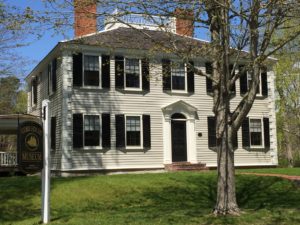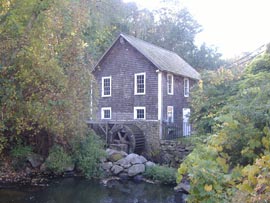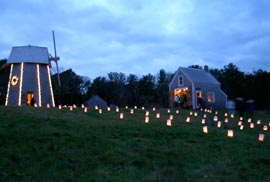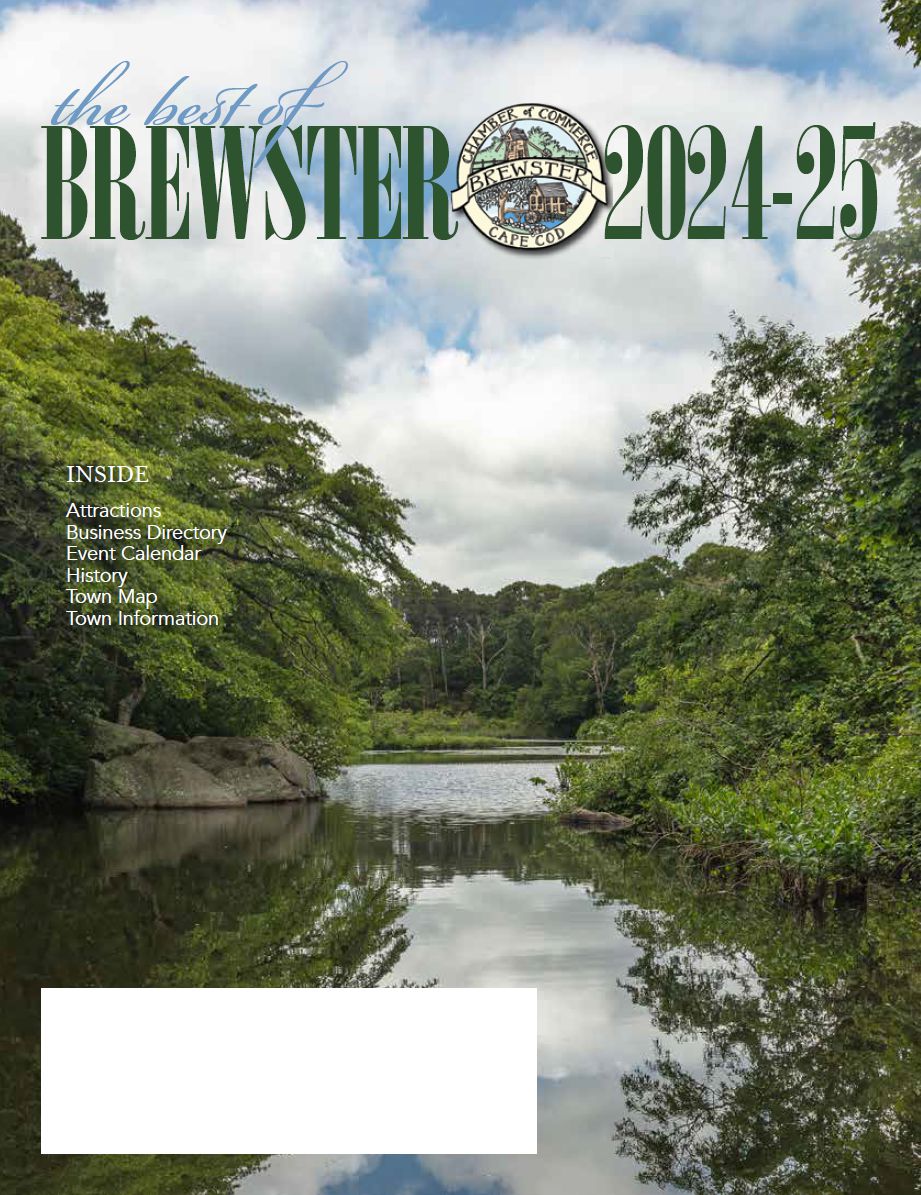Brewster Historic Sites
Cape Cod’s Sea Captains’ Homes
Brewster earned the nick name “Cape Cod’s Sea Captains’ Town” for the 50+ sea captains who called the town home in the 18th and 19th centuries. They constructed elegant mansions for their families’ comfort, and today many of them provide comfort for the visiting public.
The Historic Inns of Brewster are listed among the top 20 inns on Cape Cod and include Brewster by the Sea, Candleberry Inn, Captain Freeman Inn, Old Manse Inn and the Sea Meadow Inn. Each of these inns has a unique story, now owned and managed by innkeepers who are dedicated to preserving the elegant ambience, as well as history, of these homes. They are located along Route 6A, and several times a year, the innkeepers hold tours of the properties so the public can experience Brewster’s past.

Captain Elijah Cobb House: Brewster Historical Society Museum
Captain Elijah Cobb was born in Brewster July 4, 1768. He is arguably Brewster’s most famous sea captain, traveling around the world and landing in France in time to run afoul of its Revolution.
His ship’s cargo of rice and flour was confiscated to feed the starving populace, he engineered a private meeting with Robespierre, and stayed long enough to witness his beheading.
In the late 1700’s Captain Cobb wrote home from sea: “My partner [sic] in life’s voyage has run me in debt for a Cape Cod farm.” He built the home at 739 Lower Road in 1799 which serves today as museum and headquarters for The Brewster Historical Society.
The Cobb House offers six exhibit galleries with interactive stations featuring Brewster’s sea-faring days, domestic life, and historic treasures from the Society’s collections. Visit www.brewsterhistoricalsociety.org for hours and information.
Crosby Mansion: A Story of Romance and Opulence
Crosby Mansion is preserved as a monument to an earlier time, owned by the Commonwealth of Massachusetts and maintained by the non-profit group Friends of Crosby Mansion as a living history tribute to the past.

Located off Main St. (Rte. 6A) on Crosby Lane in East Brewster, the elegant grounds are open to the public for walking all summer. The mansion is open with guided tours during docent-led open houses held in July and August – visit www.Brewster-CapeCod.com/events.htm for dates.
Albert Crosby was born in 1823 and raised in a modest cape house in Brewster that still stands where the mansion is, as he had the mansion wrap around his old family homestead. Albert moved to Chicago and made his fortune producing distilled alcohol which he sold to the army during the Civil War. Sales of this non-taxed medicinal alcohol made him a wealthy man.
Albert returned to the Cape with a bride twenty years his junior and spared no expense to build her the three story, thirty-five room home overlooking Cape Cod Bay. Completed in 1888, the home was named “Tawasentha” built in the grand style of Chicago’s Gold Coast Mansions and featured a sixty-foot viewing tower, fifteen fireplaces with imported tile, hand carved mahogany and oak walls, a parlor fashioned after one at the Palace of Versailles, an entrance duplicating one at Buckingham Palace, a two-story billiard room, marble sinks and floors in the baths, and gas lighting and heating throughout. Because of its heightened construction, the Old Colony Railroad laid a side track to the site. The mansion was designed for the lavish entertaining his young wife, Matilda, loved. Legend has it that when her soirees became too much for him, Albert would slip away to the old homestead and sit peacefully in his favorite rocking chair.
The mansion’s crowning glory was a two-story 75’ X 50’ art gallery filled with valuable paintings and statuary, including works by Childe Hassan, El Greco, Albert Bierstadt and other famous artists. After Albert’s death in 1906 at the age of 83, Matilda opened the art gallery to the public one day a week in summer, apparently in return for the town’s not raising her taxes. The gallery was legendary, and a number of famous people were said to have visited, including the Duke of Wales, Helen Keller and Samuel Clemens. Visit www.CrosbyMansion.com or call 508-896-1744 for more information.
First Parish Brewster Unitarian Universalist Church
Founded in 1700, this was originally a Puritan church.
It was the law at that time that there be a church within five miles’ walking distance of the homes in any community and the original building was the center of town.
The current sanctuary is the third building on this site, built in 1834.

In 2012, the Brewster Meeting House Preservation Project worked to marshal resources to make much needed repairs, including: lifting the building and setting it back down on an entirely new foundation, a new roof, new timbers, a new plaza, improved access for wheelchair users and others, and more. The Project continues to raise funds for the preservation of the building and to invite use of the Meeting House as a center for the arts and community gatherings in the wider Brewster area and beyond.
Unitarianism was formalized as a denomination in 1825. First Parish was among many Puritan churches that leaned toward the new Unitarian ways of thinking and became a Unitarian church sometime in the mid-1800s. In 1961 Unitarians and Universalists consolidated into one, and this congregation thus became a Unitarian Universalist community.
The polity—how decisions are made—is congregational: that is, the members of the church decide who their “called” ministers will be and who their Board of Trustees will be, and it is the membership of the church that supports the work of the church financially and with volunteer work in the office, in action groups and task forces, and on committees.
Stony Brook Grist Mill: First Business in Brewster

The intersection of Satucket & Stony Brook Roads is a favorite place for local residents as well as visitors. It is a location of great natural and historical interest, featuring a picturesque mill beside a sparkling stream. Footpaths on both sides of the road meander along the edge of Stony Brook. Informative signs provide details about the area’s rich history.
The Grist Mill, beside Stony Brook, is a quiet reminder that this location was a busy 17th Century industrial area. If you close your eyes you can imagine the Factory Village that was started here in 1633. The grist mill grinding corn, the fulling mill felting home-made wool fabric, the shoe and furniture factories hard at work providing goods for the residents of the area. A testimony to the entrepreneurial spirit of Brewster’s residents!
The present Grist Mill was built in 1873 on the foundation of the old fulling and woolen mill. Water flowing over the water wheel creates power to grind corn between giant millstones. The Town of Brewster bought the mill and surrounding area in 1940. After recent years of refurbishments, the Mill is open grinding corn again as well as the museum. Open Saturdays from 10am-2pm, late June-August. Take home some corn meal to make fresh corn muffins!
Stony Brook Herring Run: A Cape Cod Classic
Adjacent to the Grist Mill, the Stony Brook Herring Run is Brewster’s harbinger of spring. Sometime in mid-April or as late as early May (depending on air and water temperatures), the news that “The herring are running!” spreads quickly through Brewster. Hordes of herring migrate up Stony Brook from the salt water of Cape Cod Bay to spawn in the pond waters of West Brewster. The Herring Run’s paths flanking the stream are a great place to observe the alewives’ awe-inspiring journey up the fish ladders. The Run is considered a Cape Cod classic.

Windmill Village and Band Stand at Drummer Boy Park: Americana at its Best

773 Main Street, West Brewster is home to Brewster’s Drummer Boy Park with the Windmill Village, Bandstand and Playground.
The site offers a spectacular view from Route 6A, across Quivet Creek to Cape Cod Bay.
Two 18th century buildings of historical interest – Old Higgins Farm Windmill and the Harris Black House – are situated nearby. The old Blacksmith’s Shop (which is a working shop!) rounds out the Windmill Village. These are owned and maintained by the Brewster Historical Society and are open on summer weekends for tours. See the Calendar of Events for dates and times.
On Sunday evenings at 6 pm in July and August bring a picnic and lawn blanket and enjoy the music of The Brewster Band. (And at the Drummer Boy Playground the little ones can work out their energy!) This all volunteer band has been performing for over 20 years now pleasing audiences both young and old. The Band is under the direction of John New who teaches music and band at Nathaniel H. Wixon Innovation School in South Dennis. Band members say, “John is a highly skilled professional who delights the Band’s members as he coaches and challenges them to new levels of performance.” They are always looking for musicians who would like to join! Visit www.thebrewsterband.weebly.com for more information.
Crosby Mansion: A Story of Romance and Opulence
Crosby Mansion is preserved as a monument to an earlier time, owned by the Commonwealth of Massachusetts and maintained by the non-profit group Friends of Crosby Mansion as a living history tribute to the past.
The Best of Brewster
Local Weather
part of the c4.net network.
Tides
Cape Cod tides and currents are provided by CapeTides.com, a part of the c4.net network. Visit CapeGuide.com for information about Cape Cod, Martha's Vineyard, & Nantucket.

 View the Best of Brewster 2024-25 Magazine
View the Best of Brewster 2024-25 Magazine
